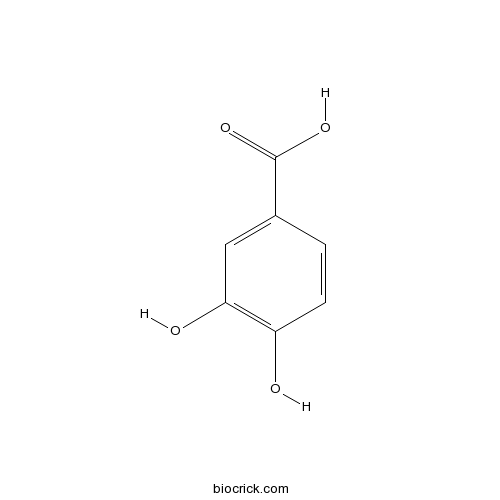Viscum coloratum
Viscum coloratum
1. The products in our compound library are selected from thousands of unique natural products; 2. It has the characteristics of diverse structure, diverse sources and wide coverage of activities; 3. Provide information on the activity of products from major journals, patents and research reports around the world, providing theoretical direction and research basis for further research and screening; 4. Free combination according to the type, source, target and disease of natural product; 5. The compound powder is placed in a covered tube and then discharged into a 10 x 10 cryostat; 6. Transport in ice pack or dry ice pack. Please store it at -20 °C as soon as possible after receiving the product, and use it as soon as possible after opening.
Natural products/compounds from Viscum coloratum
- Cat.No. Product Name CAS Number COA
-
BCN1025
Nicotinamide98-92-0
Instructions

-
BCN4537
3,4-Dihydroxybenzoic acid99-50-3
Instructions

Simultaneous identification and quantification of the common compounds of Viscum coloratum and its corresponding host plants by ultra-high performance liquid chromatography with quadrupole time-of-flight tandem mass spectrometry and triple quadrupole mass spectrometry.[Pubmed: 28738255]
None
iTRAQ-Based Quantitative Proteomic Analysis of the Inhibitory Effects of Polysaccharides from Viscum coloratum (Kom.) Nakai on HepG2 Cells.[Pubmed: 28676664]
None
Microenvironment in the canopy rivals the host tree water status in controlling sap flow of a mistletoe species.[Pubmed: 28338947]
Mistletoes absorb water from the vascular system of their hosts and thus the water use of mistletoes can be influenced by the water status of their hosts besides abiotic environmental conditions; however, there is a lack of studies on the dynamics of mistletoe water utilization in relation to both types of controlling factors. By building a canopy platform at 20 m above the ground, we monitored the dynamic changes of sap flow of Viscum coloratum (Kom.) Nakai (Loranthaceae) in combination with continuous measurements of microclimatic variables and volumetric water content (VWC) of its host tree branch xylem. We found that the host tree VWC exhibited substantial fluctuations during sunny days but lower VWC of the host did not negatively affect the sap flow of V. coloratum. Hourly and daily mean transpiration rates (Esap) of V. coloratum calculated from sap flow measurements showed strong positive correlations with photosynthetic photon flux density (PPFD) and vapor pressure deficit (VPD) measured in close vicinity to the point of mistletoe attachment. The mean Esap of V. coloratum was substantially higher than that of their host during clear days (4.55 ± 0.54 vs 2.01 ± 0.15 kg m-2 day-1). Moreover, the mistletoe-to-host transpiration ratio was not constant but became increasingly larger with the increase of PPFD or VPD on both hourly and daily bases, suggesting a weaker control of water loss in the mistletoe in comparison to its host species. The strong dependence of mistletoe Esap on micrometeorological variables and its decoupling from the host tree xylem water status suggests that the development of dense tree canopy functions as a potential mechanism for the host trees in reducing the competitive water use of mistletoes. These findings have important implications for the interactions between mistletoe species and their host trees in temperate forests.
Inhibitory Effects of Viscum coloratum Extract on IgE/Antigen-Activated Mast Cells and Mast Cell-Derived Inflammatory Mediator-Activated Chondrocytes.[Pubmed: 28036032]
None
Viscolin Inhibits In Vitro Smooth Muscle Cell Proliferation and Migration and Neointimal Hyperplasia In Vivo.[Pubmed: 27977759]
Viscolin, an extract of Viscum coloratum, has anti-inflammatory and anti-proliferative properties against harmful stimuli. The aim of the study was to examine the anti-proliferative effects of viscolin on platelet derived growth factor-BB (PDGF)-treated human aortic smooth muscle cells (HASMCs) and identify the underlying mechanism responsible for these effects. Viscolin reduced the PDGF-BB-induced HASMC proliferation and migration in vitro; it also arrested HASMCs in the G0/G1 phase by decreasing the protein expression of Cyclin D1, CDK2, Cyclin E, CDK4, and p21Cip1 as detected by Western blot analysis. These effects may be mediated by reduced PDGF-induced phosphorylation of ERK1/2, JNK, and P38, but not AKT as well as inhibition of PDGF-mediated nuclear factor (NF)-κB p65 and activator protein 1 (AP-1)/c-fos activation. Furthermore, viscolin pre-treatment significantly reduced neointimal hyperplasia of an endothelial-denuded femoral artery in vivo. Taken together, viscolin attenuated PDGF-BB-induced HASMC proliferation in vitro and reduced neointimal hyperplasia in vivo. Thus, viscolin may represent a therapeutic candidate for the prevention and treatment of vascular proliferative diseases.
Purification, characterization and anti-proliferation activities of polysaccharides extracted from Viscum coloratum (Kom.) Nakai.[Pubmed: 27261737]
Three polysaccharides, VCP1, VCP2 and VCP3 were isolated from Viscum coloratum (Kom.) Nakai using DEAE-cellulose chromatography. VCP1 (32KDa) was composed of glucose, galactose, arabinose, rhamnose and mannose, while VCP2 (280KDa) and VCP3 (21KDa) were consisted of glucose, galactose, arabinose, rhamnose, mannose, glucuronic acid and galacturonic acid. The optical rotation was measured at 20+1°C. The characteristic absorptive bands of purified fraction were determined by FT-IR. (13)C NMR spectroscopy analysis showed that VCP1 was a neutral polysaccharide, and VCP2 and VCP3 were RG-I type pectin. The linkage patterns of VCP2 were evaluated by methylation analysis: 1,5-linked Araf, 1,4-linked Galp, 1,2-linked Rhap, and 1,2,4-linked Rhap. The degree of esterification was 50%. The anti-proliferation ability against HepG2 cells and HepG2.2.15 cells of VCP2 was stronger than VCP1 and VCP3. So the polysaccharides from Viscum coloratum (Kom.) Nakai could be used as potential natural sources with inhibiting tumor cells proliferation.


